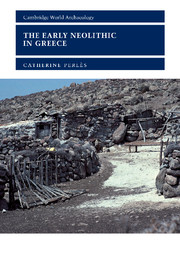Book contents
- Frontmatter
- Contents
- List of figures
- List of tables
- Acknowledgements
- Introduction
- 1 The land and its resources: the geographic context
- 2 The Mesolithic background
- 3 The introduction of farming: local processes, diffusion or colonization?
- 4 Foreign colonists: where from?
- 5 The earliest Neolithic deposits: ‘aceramic’, ‘pre-pottery’ or ‘ceramic’?
- 6 The spread of the Early Neolithic in Greece: chronological and geographical aspects
- 7 A case study in Early Neolithic settlement patterns: eastern Thessaly
- 8 Early Neolithic subsistence economy: the domestic and the wild
- 9 The Early Neolithic village
- 10 Craft specialization: the contrasting cases of chipped-stone tools, pottery and ornaments
- 11 A variety of daily crafts
- 12 Ritual interaction? The miniature world of ‘dolls or deities’
- 13 Interacting with the dead: from the disposal of the body to funerary rituals
- 14 Interactions among the living
- Conclusion
- Bibliography
- Index
10 - Craft specialization: the contrasting cases of chipped-stone tools, pottery and ornaments
Published online by Cambridge University Press: 18 December 2009
- Frontmatter
- Contents
- List of figures
- List of tables
- Acknowledgements
- Introduction
- 1 The land and its resources: the geographic context
- 2 The Mesolithic background
- 3 The introduction of farming: local processes, diffusion or colonization?
- 4 Foreign colonists: where from?
- 5 The earliest Neolithic deposits: ‘aceramic’, ‘pre-pottery’ or ‘ceramic’?
- 6 The spread of the Early Neolithic in Greece: chronological and geographical aspects
- 7 A case study in Early Neolithic settlement patterns: eastern Thessaly
- 8 Early Neolithic subsistence economy: the domestic and the wild
- 9 The Early Neolithic village
- 10 Craft specialization: the contrasting cases of chipped-stone tools, pottery and ornaments
- 11 A variety of daily crafts
- 12 Ritual interaction? The miniature world of ‘dolls or deities’
- 13 Interacting with the dead: from the disposal of the body to funerary rituals
- 14 Interactions among the living
- Conclusion
- Bibliography
- Index
Summary
In Greece, as elsewhere, archaeological traditions have paid little attention to the organization of Neolithic craft productions. The ‘German School’, headed by VI. Milojčić, concentrated on chrono-cultural classifications, based on the shape and decoration of potteries. The ‘British School’, led by E. Higgs and C. Renfrew, took a more resolutely economic orientation. Yet, until Torrence's pioneering study (Torrence 1986), the latter did not include the production of domestic tools and implements. Following Childe's models, the organization of production was assumed to be village-based and simple (Childe 1951a). Few questioned that the technical options could be explained in purely utilitarian terms, disregarding the new demands, new possibilities and new constraints that sedentism and farming set on craft production.
On the whole, artefacts were studied not as the product of an ‘art’, but as ‘finished objects’, from purely formal or aesthetic points of view. The knowledge, skills and technical choices involved in their manufacture were basically ignored, and so were, consequently, the cultural, economic and social choices that underlay the organization of production. Yet, how the artefacts were produced and what they were used for was an integral part of social strategies: ‘the Neolithic is not an “economy” but a mode of human behaviour, in which socially transmitted ideas about what kind of raw materials and what species of plants and animals to exploit, and in what way to do so, are applied both to subsistence and non-utilitarian ends’ (Nandris 1990: 12).
- Type
- Chapter
- Information
- The Early Neolithic in GreeceThe First Farming Communities in Europe, pp. 200 - 226Publisher: Cambridge University PressPrint publication year: 2001



